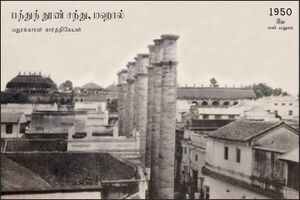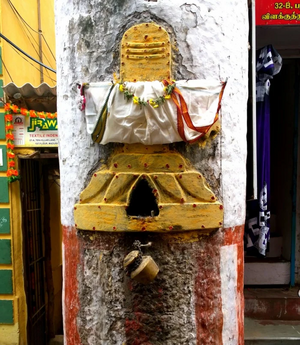Pathu Thoon (Madurai): Difference between revisions
| Line 17: | Line 17: | ||
During the Nayakkar rule, silk weavers from Saurashtra were made to settle in Madurai along the palace. As silk was a valuable product, they lived in guarded streets. When the Palace complex was abandoned, they built houses around the Ten Pillars (Pathu Thoon) and settled there. The lane which was famous for silk threads, was later filled with small textile shops. | During the Nayakkar rule, silk weavers from Saurashtra were made to settle in Madurai along the palace. As silk was a valuable product, they lived in guarded streets. When the Palace complex was abandoned, they built houses around the Ten Pillars (Pathu Thoon) and settled there. The lane which was famous for silk threads, was later filled with small textile shops. | ||
== Structure == | == Structure == | ||
These pillars were formed by stacking round granite stones. Upon these, lime plaster and bricks were applied to smoothen and make it similar to pillars in the palace. All the ten pillars are of the same height and do not have any sculptures. Each pillar is 12 meter high and has a circumference of 1.20 meter. As per the engineers, these pillars were erected to bear the full weight of the Rangamahal palace constructed out of bricks and plaster. The weight of these pillars stabilized the palace. In one of these ten pillars (Pathu Thoon) a shivalingam sculpture is embossed. | |||
== Nearby Archeological Sites == | == Nearby Archeological Sites == | ||
Sites like Raaya Gopuram, Thirumalai Nayakkar Mahal are present near the Pathu Thoon. | Sites like Raaya Gopuram, Thirumalai Nayakkar Mahal are present near the Pathu Thoon. | ||
Revision as of 18:04, 16 June 2022
இந்தப் பக்கத்தை தமிழில் வாசிக்க: பத்துத் தூண் (மதுரை)
Pathu Thoon (Ten Pillars) 1636 AD are ten big stones located in Madurai. These belong to the Thirumalai Nayakkar period. Archeologists consider these pillars to be the frontage of Muthiyaalu Nayakkar's palace. He is the younger brother of Madurai Thirumalai Nayakkar.
Location
Pathu Thoon lane is located amidst the Navabath Kana street and Mahal Vadampookki street, situated north of the Thirumalai Nayakkar's palace in Madurai. The Pathu Thoon is engulfed by houses present in the lane. Madurai Meenakshi Amman temple and Thirumalai Nayakkar Mahal are located near the Pathu Thoon . It can be reached via a congested lane called Vilakku Thoon (lamp pillar).
History
Swarga Vilasam palace built by Thirumalai Nayakkar in Madurai is called as Thirumalai Nayakkar Mahal in recent times. As part of this palace, Ranga Vilasam palace was constructed in 1636 AD as a residence for Thirumalai Nayakkar's younger brother Muthiyaalu Nayakkar. Pathu Thoon or the Ten Pillars is said to be the frontage of that palace, Ranga Vilasam. Other sections of that palace are not present anymore.
R. Venkataraman, historian specializing in Madurai history says, 'after the life of Thirumalai Nayakkar, Head-quarters of Naykkar Kingdom changed from Madurai to Thrichy. During this time, the precious segments of the Ranga Vilasam were transported and rest were abandoned'. Later, the forts at the north side were damaged during the Madurai invasion of Chanda Sahib and in the course of time vanished. Presently, only the Pathu Thoon remain.
Pathu Thoon (Ten Pillars) were declared as archeological monuments of Tamil Nadu on July 20, 1973 and are protected by the Tamil Nadu State Department of Archaeology.
மதில் இடிப்பு
திருமலை நாயக்கர் மகாலின் வடக்கு பகுதியில் அமைந்த பத்து தூண்களுக்கு கிழக்கே ஒரு நுழைவாயில் இருந்திருக்கிறது. அதற்கான மதில் 274 மீட்டர் நீளமும், 183 மீட்டர் அகலமும், 12 மீட்டர் உயரமும் கொண்டதாய் விளங்கியது. இடிந்து விழுந்து ஆபத்து ஏற்படுத்தும் நிலையில் இருந்ததால், இந்த சுவர் 1837- ஆம் ஆண்டு இடிக்கப்பட்டது.
Pathu Thoon Lane
During the Nayakkar rule, silk weavers from Saurashtra were made to settle in Madurai along the palace. As silk was a valuable product, they lived in guarded streets. When the Palace complex was abandoned, they built houses around the Ten Pillars (Pathu Thoon) and settled there. The lane which was famous for silk threads, was later filled with small textile shops.
Structure
These pillars were formed by stacking round granite stones. Upon these, lime plaster and bricks were applied to smoothen and make it similar to pillars in the palace. All the ten pillars are of the same height and do not have any sculptures. Each pillar is 12 meter high and has a circumference of 1.20 meter. As per the engineers, these pillars were erected to bear the full weight of the Rangamahal palace constructed out of bricks and plaster. The weight of these pillars stabilized the palace. In one of these ten pillars (Pathu Thoon) a shivalingam sculpture is embossed.
Nearby Archeological Sites
Sites like Raaya Gopuram, Thirumalai Nayakkar Mahal are present near the Pathu Thoon.
Current State
பத்துத் தூண்கள் தொல்லியல் துறை கட்டுப்பாட்டில் உள்ளன. ஆனால் அப்பகுதி முழுமையாகவே ஆக்ரமிப்பில் உள்ளது. கடைகள் நிறைந்துள்ளன. அவர்களின் தட்டிகள் பத்துத்தூண்களில் ஆணிகள் அறையப்பட்டு கட்டப்பட்டுள்ளன. பார்வையாளர்கள் நின்று பார்க்கமுடியாதபடி இடுங்கலான நெரிசலான சந்துக்குள் ஏராளமான துணிப்பொதிகளும் அடுக்கி வைக்கப்பட்டுள்ளன.
Reference
- Madurai Nayakar's history, A. K. Paranthamanar
Links
🔏Being Created-en
Please do not write any content below this line. This section is only for editing templates & categories.



